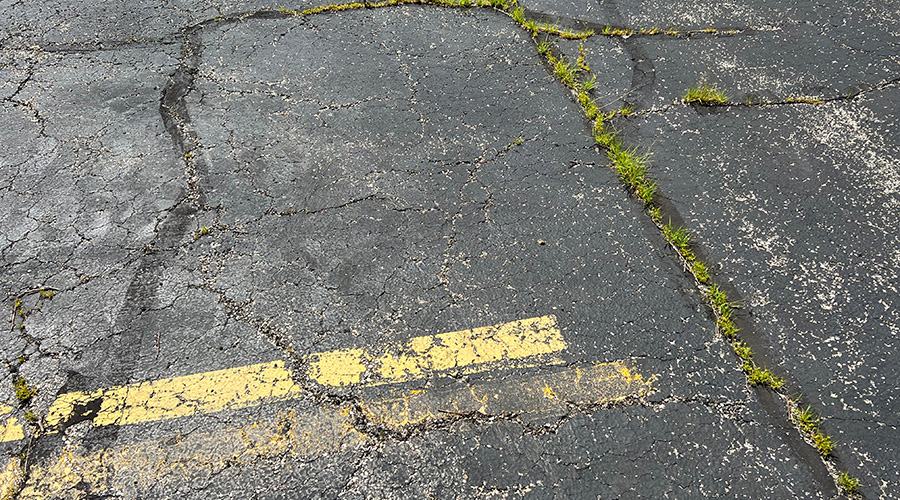The Challenges of Parking Lots: What to Look Out For
Parking lots and structures are the first thing visitors see at facilities. Their condition can make good or bad lasting impressions.
By Frank Rigas, Contributing Writer
“You never get a second chance to make a first impression.” The impression a person gets when stepping onto the property of an institutional or commercial facility for the first time is critical.
When a building visitor or employee approaches a facility’s parking lot, its condition can influence a visitor’s first impression of the building or organization that manages it.
“The parking lot serves as a first point of contact for everyone entering the site,” says Alex Straughn, production manager with Beverly Companies, a provider of outdoors services, including asphalt installation, maintenance and repair. “A smooth, clean and properly maintained lot reflects professionalism and attention to detail. Deteriorating surfaces can lead to negative perceptions of the facility and brand being represented as a whole.”
Those negative perceptions can further be exacerbated by an injury sustained because of a poorly maintained or unsafe surface.
“Maintaining surfaces like parking lots for facilities is primarily about safety,” says Troy Richardson, regional operations manager with ESFM. “It is important to minimize risk from slips, trips and falls whenever possible. I think people take greater pride in their work when parking lots and paving is aesthetically appealing. It’s a visual indicator that safety is prioritized.”
Main culprits
There are a number of causes of potholes, cracks and other problems that develop in asphalt surfaces that maintenance and engineering managers must contend with. Those hurdles include:
Weather extremes. Temperature fluctuations, especially freeze-thaw cycles, can cause asphalt to expand and contract, leading to cracks and potholes.
“Rainwater seeping into these cracks worsens the damage over time,” Straughn says.
Water damage. Poor drainage or standing water on the surface can weaken the foundation, lead to cracks, erosion and eventual potholes and “can cause the base and subbase to erode,” Richardson says.
Vehicle weight. Heavy vehicles, such as delivery and trash trucks, can compress and break down asphalt not designed to support the weight.
Ultraviolet exposure. Constant exposure to the sun’s ultraviolet rays breaks down the binding agents in asphalt and causes it to dry and become brittle, which leads to cracks and fading.
Oil and chemical spills. Leaks, including oil, gasoline and other chemicals, from vehicles and machinery can cause asphalt to soften and degrade, which creates weak spots prone to further damage.
Improper installation. Poor practices, such as insufficient compaction or subgrade preparation, over time can lead to structural issues and cause asphalt to break down more quickly.
“If properly installed, concrete and asphalt should last 20-plus years without issues,” Richardson says.
Improper maintenance. Delayed, neglected or substandard maintenance, including sealcoating or cracks that are not filled properly, can turn small problems into larger problems and shorten the lifespan of the parking lot.
“Beyond aesthetics, proper maintenance reduces safety risks like tripping hazards or vehicle damage, helping to prevent liability issues,” Straughn says. “Additionally, regular upkeep extends the lifespan of the asphalt, reducing long-term costs associated with extensive repairs or full resurfacing.”
Repair or resurface?
Repairing or resurfacing parking lots is among the foremost of several challenges that managers must consider when dealing with exterior asphalt surfaces.
“One of the biggest challenges is determining whether a parking lot can be fixed with simple repairs or if it needs to be resurfaced or even fully replaced,” Straughn says. “Factors like the extent of cracking, the age of the asphalt and overall structural integrity of the base layer make this decision complex.”
Budgeting for repairs, replacement and maintenance also is challenging.
“Maintenance and repair costs can be significant, and managers often have to balance the immediate cost of repairs with the long-term investment of resurfacing,” Straughn says. “They must weigh short-term savings against potential future costs from letting issues go unresolved.”
Scheduling projects is another challenge for managers. Since many facilities are routinely centers of high levels of activity, determining when to begin and complete a project while minimizing disruptions can be difficult, forcing managers to prioritize projects.
“Managers must also consider the impact on daily operations,” Straughn says. “Scheduling repairs or resurfacing without disrupting customer access, employee parking or deliveries can be difficult, especially for busy commercial properties.
“For large parking lots or campuses, managers may have to prioritize which sections to repair first, making decisions based on use patterns, traffic loads or the severity of damage in certain areas.”
Finding reliable and experienced contractors is essential.
“Managers need to ensure the contractor understands the specific needs of the facility, provides accurate quotes and has the expertise to recommend the best solutions,” Straughn says.
Richardson says managers also need to get multiple bids for projects, speak with an expert during the process and consider their location when choosing a contractor.
“Be sure the contractor has experience in your market, as there are regional differences that may need to be considered for the work to be done properly,” he says.
Straughn says added challenges include:
- Longevity vs. cost. Deciding between cost-effective, short-term repairs and longer lasting but more expensive, resurfacing options.
- Weather and seasons. Finding the right time for repairs or resurfacing because asphalt work is weather-dependent and can be difficult, especially in regions with extreme weather.
- Environmental impact. Balancing the effects of traditional asphalt and using more eco-friendly materials or processes, which might cost more or be less available.
Myths and misconceptions
When a parking lot project is completed, the manager’s job is still not complete. Proper maintenance is required to extend the life of the project.
“A common misconception is that deferring maintenance saves money in the long run,” Richardson says. “We often see that a small problem can become a much bigger problem if not handled quickly. For example, moisture infiltration into the base and subbase through cracks in parking lots can result in larger failures if not addressed quickly.”
Other misconceptions include these:
- Asphalt is maintenance-free. “Many facility managers assume that once asphalt is laid, it doesn’t require upkeep,” Straughn says. “In reality, asphalt requires regular maintenance, such as crack sealing, sealcoating and patching to prevent small issues from escalating into costly repairs.”
- All cracks need resurfacing. “Not every crack or imperfection in a parking lot requires resurfacing,” he says. “Many cracks can be sealed or repaired individually if addressed early. Resurfacing is only necessary when the structural integrity of the lot is compromised.”
- Sealcoating fixes everything. “Sealcoating is often misunderstood as a fix-all solution,” Straughn says. “While it helps protect the surface from UV damage and water penetration, it doesn’t repair structural damage. It’s part of a maintenance routine, not a cure for deep cracks or potholes.”
- Repaving is better than repairing. “Many believe repaving is more effective than repairs, but targeted maintenance can often extend the lifespan of a parking lot without the high cost and downtime of full resurfacing,” he says.
As with many maintenance projects, managers need to keep one eye on efficiency and the other on their budget when making decisions.
“These misconceptions can lead to improper maintenance strategies that may increase costs and reduce the lifespan of the parking lot,” Straughn says.
Frank Rigas is a freelance writer based in Sheboygan, Wisconsin.
Related Topics:












